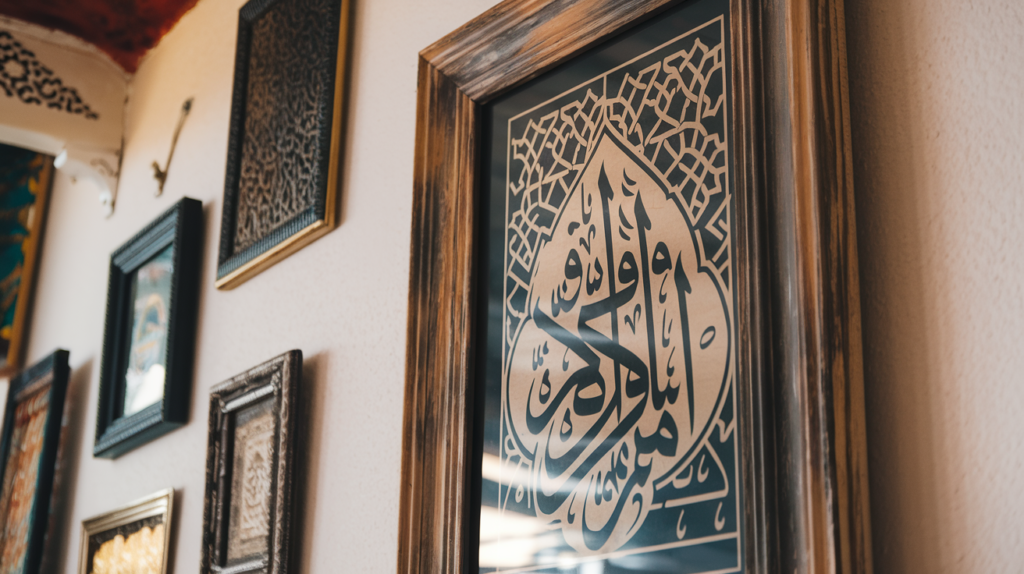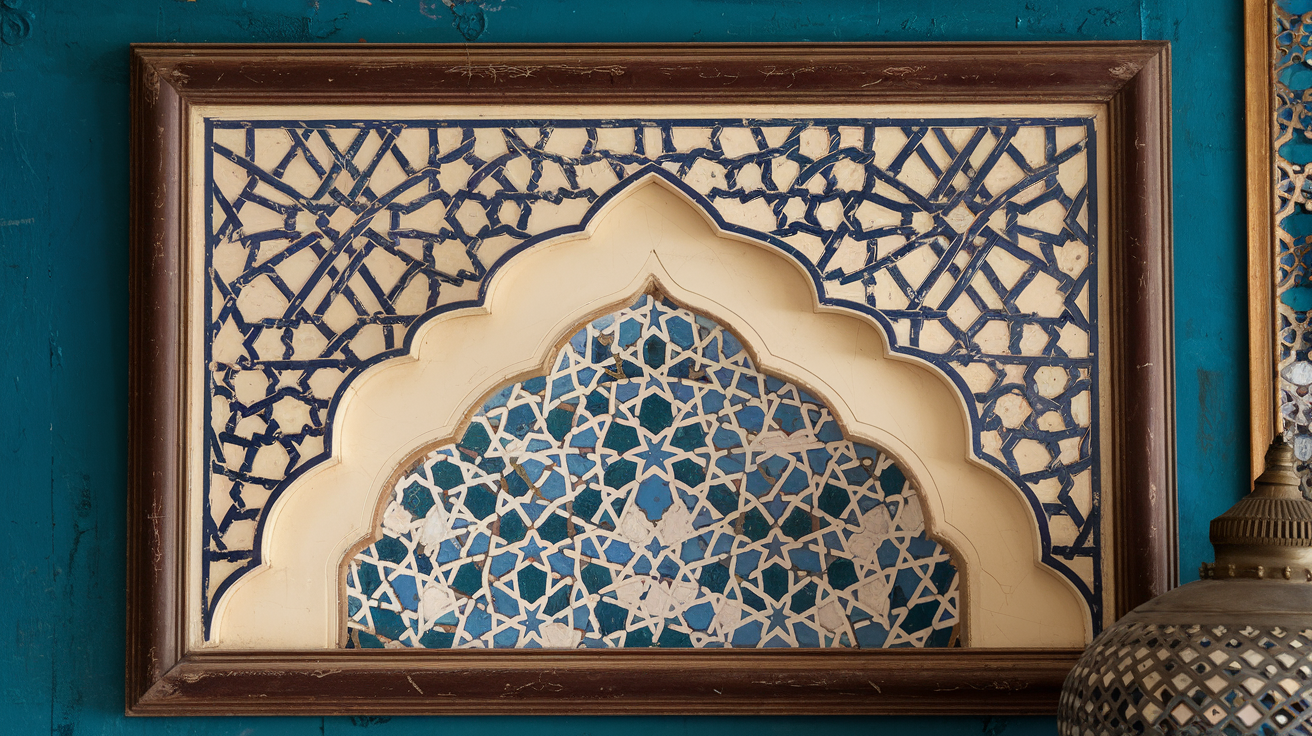If you want a special way to add charm to your room, Islamic wall art is the best choice for you. It’s got amazing geometric patterns, Arabic words, and symbols full of meaning. It turns your blank wall into a motivating center point. You can use Islamic wall art to make your house calming, honor traditions, or add a fancy touch to modern rooms.
Also, Islamic wall art has a lot to choose from for any room. In this guide, we’ll share handy tips and fun ideas. You can use Islamic art to match your home style and your own likes.
Where Did Islamic Art Come From?
In the beginning, around the 7th and 8th centuries, Islamic art was born. This happened during the early Islamic Empire. It was a time when Islam spread its wings beyond the Arabian Peninsula, all the way across Asia, Africa, and Europe. As it spread, art and architecture bloomed like never before. Each new place influenced the designs, adding elements from their unique cultures. Even so, Islamic art kept its own special features. Arabic calligraphy and geometrical designs remained vital. Early Muslim artists used these styles in mosques, palaces, and landmarks. Their work left a deep mark. Even today, you see it in modern designs of Islamic wall art.
How to Choose the Right Islamic Wall Art for Your Space
Picking out Islamic wall art for your house can mix faith, beauty, and cultural significance into your surroundings. Let’s look at vital elements to keep in mind when selecting pieces ideal for your area:
Consider the Room’s Purpose and Mood
For living rooms go for big, bold artworks or a collection of smaller pieces. Mix geometric shapes, Arabic writing, and flower images. This can make a cozy, welcoming room for family and friends. For bedrooms, You can pick soothing, simple designs, like a quiet writing work or gentle geometric shapes. This can help make a quiet, relaxing space.
Match the Art Style to Your Interior Design Them
Choose Islamic wall art that uses sharp and bold differences, such as golden and black calligraphy or basic shapes. Simple Islamic art complements today’s modern style well. Find artworks with full-bodied colors, detailed elements and traditional arabesques or flower patterns. These bring out the charm in more conventional environments. Create a blend of varying Islamic art types. You could match geometry patterns with colorful flower prints or vintage calligraphy. This combo offers a special, layered appeal to your area.
Choose the Right Size and Placement
If you want a standout feature go for a big Islamic wall art that grabs the eye. Put it over your sofa, bed, or fireplace to set the theme for the room. Set up a mini-gallery of smaller, matching artworks. This approach works great in entry places or down long corridors. In cozy spots like reading corners, pick small-sized art with detailed designs. They brings personality without crowding the area.
Focus on Colors That Complement Your Palette
Islamic wall art in mellow colors such as beige, white, or gold, adds a touch of grace. It merges seamlessly with numerous color arrangements. Conventional Islamic wall art comes in deep blues, greens, and reds. These colors bring a splash of vibrancy, particularly in monochrome spaces or those with subdued tones. Your decor’s elegance can be boosted with Islamic art pieces featuring gold or silver highlights. These work harmoniously in both contemporary and traditional settings.
How to Incorporate Islamic Wall Art Creatively

Islamic wall art offers endless ways to enhance your home with beauty, culture, and meaning. Here are some creative ideas to incorporate into your decor in unique and inspiring ways:
Create a Focal Wall with Large-Scale Art
Change your whole wall into a showcase of Islamic wall art. You can do this by using large calligraphy or a shaped mural as a standout addition. This strategy is particularly good in places like living rooms or entrances, giving a sense of elegance. On the other hand, you could choose wallpaper with Islamic designs to give the room its own unique vibe instantly.
Mix and Match Different Art Forms
Merge handwriting skills, shapes, and flower patterns on a single wall. This results in different layers interacting, giving a unique look. Set up various frames and canvas sizes for a wall gallery. This creates an active visual showcase. You can also blend Islamic wall art with other items. Think about adding framed pictures from your trips or old relics. This combination forms a gallery that is unique to you and your life experiences.
Incorporate Art on Functional Pieces
Seek out interior items with Islamic-design elements. Consider tables, lamps, or mirrors showing elaborate shapes or arabesque patterns to match the wall art and tie the room theme together. Use functional art with Islamic themes such as clocks, trays, and ceramic plates. Hang these as wall decorations in your kitchen, dining area, or corridors.
Use Layered Canvas and Floating Art
Layered canvas panels can be placed in a slightly staggered manner to create a 3D look. This method brings depth, and it makes the wall seem more lively. Glass frames that float and have Islamic script or designs can create a fresh, modern vibe. These make it seem like the design is floating on the wall, which is perfect for modern home designs.
Highlight Corners and Smaller Spaces
Consider applying Islamic wall art in surprising locations like cozy corners, reading spots, or close to the natural light of windows. A tiny yet detailed work, such as a single verse in calligraphy, can transform these locations into reflective spots of inspiration. A minimal array of tiles or mini figurines boasting Islamic patterns can infuse character into these normally unnoticed areas.
Conclusion
If you want a touch of beauty, meaning, and cultural richness in your home, Islamic wall art does just that. From detailed patterns to standout writing and flower designs, it brings life to plain walls. A selection that suits each room’s purpose, fits your decor, and matches your tastes can create a welcoming, balanced feel. Islamic wall art offers countless possibilities, whether you aim to make a strong impression, bring in a calming element, or use art in practical ways. This art not only brings aesthetic appeal to your home but also serves as an important reminder about faith, culture, and ageless craftsmanship. It adds a unique charm and purpose to your day-to-day setting.

